Wine in Moderation as Part of a Healthy Lifestyle...
Prologue
”God gave the grape, the wine, to make to please both great and small
But little fools then drink too much and big ones not at all”
Anonymous
There are probably more papers published in the scientific literature on alcohol than on any other singular
subject and the word moderation appears over and over in referencing healthy alcohol consumption. The
importance of moderation in alcohol intake has been realized since antiquity. Hippocrates, the Father of
Western Medicine, advocated the use of wine to treat practically every illness he had identified: “Wine is fit for
man in a wonderful way, provided that it is taken with good sense by the sick as well as the healthy.”
Paracelsus, a German physician in the Middle Ages, considered the Father of Pharmacology, invented the
word alcohol and stressed the tonic value of wine: “Whether wine is nourishment, medicine or poison, is a
matter of dosage.”
The praise for and urging for moderation in alcohol consumption has been a refrain for centuries. Albert de
Sallengre wrote in 1714 in his book, The Praise of Drunkenness, “Do not force someone to drink; do not drink
too often; always drink good wine in good company at the right time; and, last but by no means least, know
your limits.” Abraham Lincoln noted, “It has long been recognized that the problems with alcohol relate not to
the use of a bad thing, but to the abuse of a very good thing.” Herrmann “Jackrabbit” Smith-Johannsen, a
Norwegian-Canadian who was one of the first people to introduce the sport of cross country skiing to Canada
and North America, died at age 103 in 1987. When asked what the secret to his longevity was, he said, “The
secret to a long life is to stay busy, get plenty of exercise and don’t drink too much. Then again, don’t drink too
little.”
It is clear from the quotes of those who preceded us that they were aware of a boundary between the health
benefits of wine and hazardous imbibing. The term, hormesis, applies here, meaning a biological phenomenon
in which the favorable effect of moderate dosage of a substance is toxic in higher doses.
The current (2010) United States Dietary Guidelines for Americans emphasizes moderation:
1. Don’t begin drinking or drink more frequently on the basis of potential health benefits.
2. If you do choose to drink, do so in moderation. This is defined as up to 1 drink a day for women or 2 for
men.
3. Don’t drink at all if you are under age 21, pregnant or may be pregnant,or have health problems that could
be made worse by drinking.
The National Institutes of Health Guidelines (2011) are similar:
1. Moderate or “low-risk” drinking for men is no more than 4 drinks on any single day AND no more than 14
drinks per week, and for women no more than 3 drinks on any single day AND no more than 7 drinks per
week.
2. Heavy or “at-risk” drinking for adults means consuming more than the single-day or the weekly amounts
listed in above.
To understand “moderate drinking,” which is frequently referenced in this issue and in the following abstracts of
research studies, a few definitions are in order. In the United States, a standard drink (or unit) contains 17.7 ml
or 14 gm or 0.6 ounces of ethanol which is equivalent to 12 ounces of beer, 5 ounces (150 ml) of 12% ABV
wine, and a shot (1.5 ounces) of 80-proof distilled spirits or liquor. A full bottle of wine contains 750 ml or 25
ounces which is 5 to 7 standard drinks depending on the alcohol percentage. To determine the number of
drinks in a bottle, multiple 750 ml by the alcohol percentage and divide by 17.7. A bottle of 16% alcohol will
have about 1 more drink than a bottle of 13% alcohol, the point being that alcohol percentage does make a
difference when you are looking to drink in moderation. The amount of alcohol consumed rises more rapidly
per unit volume ingested as the alcohol percentage goes higher. One would want to scale back the volume of
drinking when imbibing a wine with a higher alcohol percentage or reach for a lower alcohol wine to insure that
you stay within the confines of “moderation.”
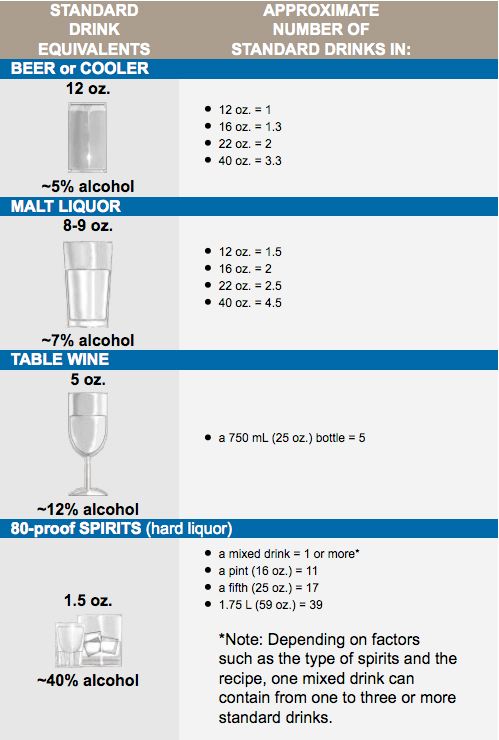
Many drinkers believe a standard drink is of greater volume than it is. This is termed the “over-sizing effect”
and leads to a false sense of drinking within the confines of moderation. Drinkers have trouble pouring
standard drinks and the norm is to over pour. According to BBC News (October 7, 2011), the Office of National
Statistics in the UK found that 82% of adults claim to know what a unit of alcohol is, but 77% don’t know how
many units are in a typical large glass of wine and only 13% kept tabs on the number of units they drank. To
use a common measure, a 4 ounce pour is 120 ml or half cup, the standard U.S. drink of 5 ounces is about two thirds
cup, and a 6 ounce pour (common in restaurants) is three quarters cup. It is very easy to pour 10 ounces into a Burgundy
glass, thinking it is one standard drink. A table showing the cumulative consumption of alcohol in ounces per
number of 5 ounce pours of wine is below:
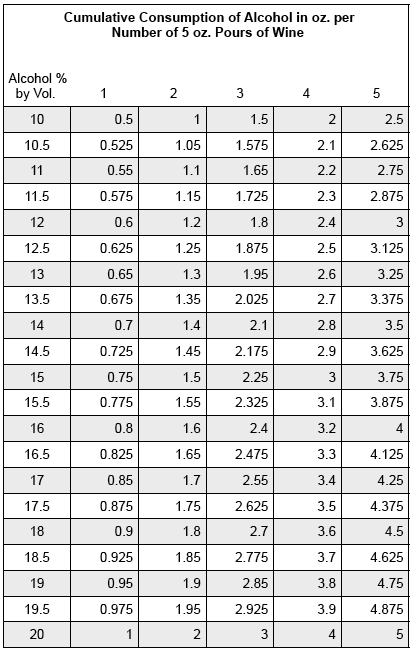
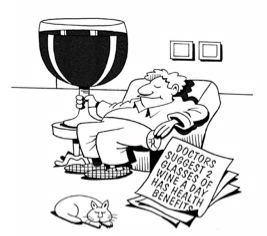
The Iowa Alcoholic Beverages Division has created a mobile site, CALCohol, that calculates alcoholic content
based on the listed proof and size of drink. If the user knows the alcohol content, the app can give a serving
suggestion. It is the first site of its kind that identifies the number of standard servings. It also can estimate the
users blood alcohol level at any time and tells the user when they will be sober (the users weight, height,
gender and age are taken into account). The app can be downloaded at www.SourceForge.net.
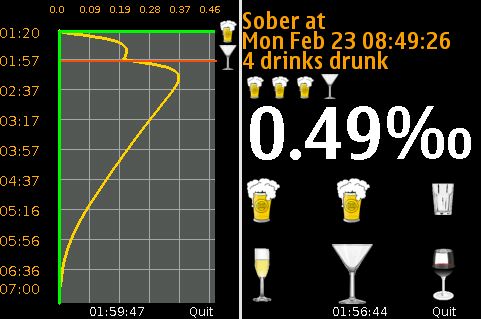
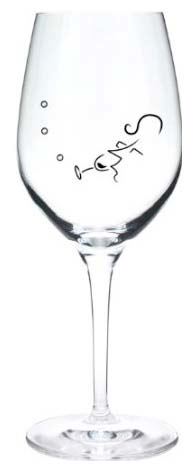
Another way to monitor drink and insure that you are within the confines of moderation is to
use a wine measuring glass such as the Moderation Wine Glasses offered by Mr. Picky
(www.mr-picky.com/moderation-wine-glasses/). The red and white glasses are made in a
Riedel factory in Germany and are endorsed by cardiologist and heart surgeon, Steven
Gundry, M.D., and author of the Sonoma Diet, Dr. Connie Guttersen. Discrete bubbles on the
glass measure 4, 6 and 8 ounces. For me, this would take some of the pleasure out of
enjoying wine. I would rather just roughly estimate using a proper wine glass.
Why are we concerned with alcohol intake and the possible gains from moderation? The
primary reason is that we drink plenty of alcohol in this nation and there are over 200 diseases
or conditions with diagnostic codes in the International Classification of Diseases-10 caused
directly or indirectly by alcohol. In 2011, Americans drank 3.7 billion bottles of wine (revealed
in a 2012 study by Vinexpo and International Wine and Spirits Research or ISWR) and the
United States is now the world’s leading wine consumer in volume and value (although we
have one of the lowest rates of drinking in the developed world, with about 20 percent of
Americans consuming 96% of the wine). The ISWR predicts United States wine consumption
will increase by 10 percent over the next four years, with Americans drinking about 13 liters of wine (3.4
gallons) per adult per year. The average American adult now drinks about 2.6 gallons of wine a year (a little
over a glass of wine a week), less than the World Health Organization reported global average of 3.3 gallons a
year. The Gallup Consumption Habits Poll from July 9-12, 2012, found that American drinkers consume just
over four alcoholic drinks per week on average with 12% consuming eight or more drinks in the past week.
Wine is closing in on beer as the favored alcoholic beverage of Americans.
The health benefits and risk of alcohol and wine in particular in the American diet is worth study. According to a
reported released January 9, 2013, by the National Research Council and Institute of Medicine, Americans live
a shorter life span and are in worse health than residents of other wealthy nations. American men had the
lowest life expectancy among men in 17 countries and women had the second-lowest life expectancy, better
than only Danish women. Americans are below average regarding a number of important health conditions,
including obesity, diabetes and cardiac disease.
The importance of moderation in wine consumption cannot be overemphasized. Over drinking can lead to a
number of very serious health problems including sudden death from high blood pressure, heart attack, cardiac
arrhythmia or stroke; cardiac myopathy, cirrhosis of the liver, acute alcoholic hepatitis, osteoporosis, chronic
gastritis, irritable bowel syndrome, tremors, insomnia, dementia, and cancer of the mouth, pharynx, larynx,
esophagus, stomach, liver, colon and breast. One is better off not drinking at all than drinking too much.
There are many challenges to medical research on alcohol in this country and trumpeting the correct message
to the American public. Lewis Purdue, who publishes the Wine Industry Insight and Daily News Fetch online
has voiced his displeasure. “The wine industry is timid, apathetic, smug and doing a pitiful job of telling the
story. Yes, that includes everybody from the Wine Institute to Family Winemakers to every state, local, county
and other wine organization in the country.” The Wine Institute, and the Federal Government for that matter,
prohibit wineries from hinting at or promoting the health benefits of wine.
Currently, federal money cannot be used to support alcohol research other than the treatment of addiction, and
funding is available only for viticulture studies and examination of grapes, raisins and other non-vinification
topics. Jake Lorenzo, writing in Wine Business Monthly (December 2012) adds his view. “There is some sinful
quality and a bit of guilt attached to drinking any alcoholic beverage. Alcohol, wine included, is regulated by the
Bureau of Alcohol, Tobacco, Firearms and Explosives under the auspices of the Department of Homeland
Security. That means wine is considered dangerous and possibly subversive by our own government.”
Purdue also points out the number of “alcohol is evil” headlines he sees every day for the Daily News Fetch
has been going up steadily along with the “AH-HAH! Wine’s not so good for you after all” articles. I see titles
like, “Daily glass of red wine might not be good for you,” frequently as I review the literature. These headlines
send a confusing message to the public and have a veil of Neo-prohibitionism. Rob McMillan (SVB on Wine at
Svbblogspot.com) notes, “Neo-prohibitionism may be less visible, yet the underlying agglomeration of strange
bedfellows isn’t yet dead.”
I can sympathize with the public’s confusion about the health benefits of wine. As a medical doctor, I have read
a considerable amount of medical literature and research on the relationship between alcoholic beverages and
health, yet I find it exasperating to successfully decipher the conflicting reports. Practically every published
research study ends with the disclaimers such as, “Further study is necessary,” “More research is needed to
explain the results,” and “The results may be explained by biases and confounding.” The word “suggestive” or
the two words “interpret cautiously” are often employed.
I believe that we need more voices that are promoting the truth about the responsible consumption of wine to
the public. I hope that this issue of the PinotFile speaks loudly to this very complicated subject. There are no
absolutes presented here, and readers are encouraged to individualize the vast amount of information and
consult with their personal physician for advice on lifestyle, diet and drinking. I agree wholeheartedly with
Becca Yeamans, who writes the Academic Wino Blog (www.academicwino.com). “The complicated nature of
both wine and the human body will make blanket statements about the health benefits of wine near
impossible.”







